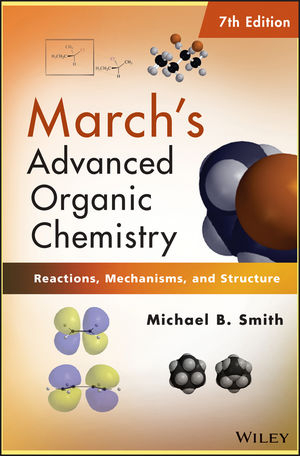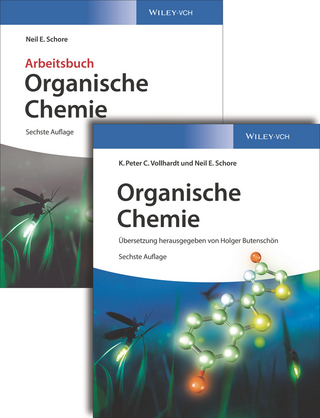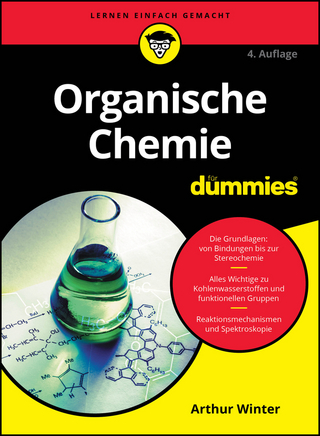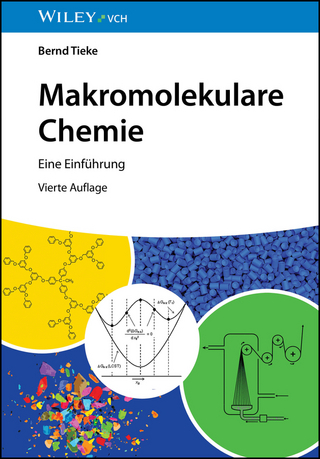
March's Advanced Organic Chemistry
Wiley-Blackwell (Verlag)
978-0-470-46259-1 (ISBN)
- Titel ist leider vergriffen;
keine Neuauflage - Artikel merken
The new, revised and updated 7th edition of March's Advanced Organic Chemistry clearly explains the theories and examples of organic chemistry, providing the most comprehensive resource about organic chemistry available.
Readers are guided on planning and execution of multi-step synthetic reactions, with detailed descriptions of all the reactions. The first five chapters deal with the structure of organic compounds and discuss important organic chemistry bonds, fundamental principles of conformation, and stereochemistry of organic molecules, and reactive intermediates in organic chemistry. Chapters 6 to 9 are concerned with general principles of mechanism in organic chemistry, including acids and bases, photochemistry, sonochemistry and microwave irradiation, and finally the relationship between structure and reactivity. The last 10 chapters cover the nature and the scope of organic reactions and their mechanisms.
The 7th edition proves again it is a must-have desktop reference and textbook for every student and professional working in organic chemistry or related fields.
Key features of the 7th edition:
* Every chapter has been updated with the most recent reaction information with references to both the primary and review literature
* New to the 7th edition: 5,500 references since the last edition, updates / rewrites of the retained sections, and an updated index in Appendix B
* Contains more than 1650 reactions and 20,000 valuable references to the primary literature
* Includes appendices on the literature of organic chemistry and the classification of reactions according to the compounds synthesized
* Guides the reader on planning and execution of multi-step synthetic reactions, with detailed descriptions of all the reactions.
MICHAEL B. SMITH, PhD, is Professor in the Department of Chemistry at the University of Connecticut. He is a coauthor of the fifth and sixth editions of March's Advanced Organic Chemistry and the author of Volumes 6 --12 of the Compendium of Organic Synthetic Methods (Wiley) as well as several other monographs.
PREFACE
BIOGRAPHICAL STATEMENT
PART 1
CHAPTER 1: LOCALIZED CHEMICAL BONDING
1.A COVALENT BONDING
1.B MULTIPLE VALENCE
1.C HYBRIDIZATION
1.D MULTIPLE BONDS
1.E PHOTOELECTRON SPECTROSCOPY
1.F ELECTRONIC STRUCTURES OF MOLECULES
1.G ELECTRONEGATIVITY
1.H DIPOLE MOMENT
1.I INDUCTIVE AND FIELD EFFECTS
1.J BOND DISTANCES
1.K BOND ANGLES
1.L BOND ENERGIES
CHAPTER TWO: DELOCALIZED CHEMICAL BONDING
2.A MOLECULAR ORBITALS
2.B BOND ENERGIES AND DISTANCES IN COMPOUNDS CONTAINING DELOCALIZED BONDS
2.C MOLECULES THAT HAVE DELOCALIZED BONDS
2.D CROSS CONJUGATION
2.E THE RULES OF RESONANCE
2.F THE RESONANCE EFFECT
2.G STERIC INHIBITION OF RESONANCE AND THE INFLUENCES OF STRAIN
2.H ppi-dpi BONDING. YLIDS
2.I AROMATICITY
2.J ALTERNANT AND NONALTERNANT HYDROCARBONS
2.K AROMATIC SYSTEMS WITH ELECTRON NUMBERS OTHER THAN SIX
2.L OTHER AROMATIC COMPOUNDS
2.M HYPERCONJUGATION
2.N TAUTOMERISM
3 BONDING WEAKER THAN COVALENT
3.A HYDROGEN BONDING
3.B ()INTERACTIONS
3.C ADDITION COMPOUNDS
3.D Catenanes and Rotaxanes
3.E Cucurbit[n]uril-Based Gyroscane
4 STEREOCHEMISTRY AND CONFORMATION
4.A OPTICAL ACTIVITY AND CHIRALITY
4.B Dependence of Rotation on Conditions of Measurement
4.C What Kinds of Molecules Display Optical Activity?
4.D THE FISCHER PROJECTION
4.E ABSOLUTE CONFIGURATION
4.E.i THE CAHN-INGOLD-PRELOG SYSTEM
4.F THE CAUSE OF OPTICAL ACTIVITY
4.G MOLECULES WITH MORE THAN ONE STEREOGENIC CENTER
4.H ASYMMETRIC SYNTHESIS
4.I METHODS OF RESOLUTION
4.J OPTICAL PURITY
4.K CIS-TRANS ISOMERISM
4.L OUT-IN ISOMERISM
4.M ENANTIOTOPIC AND DIASTEREOTOPIC ATOMS, GROUPS, AND FACES
4.N STEREOSPECIFIC AND STEREOSELECTIVE SYNTHESES
4.O CONFORMATIONAL ANALYSIS
4.P MOLECULAR MECHANICS
4.Q STRAIN
5 CARBOCATIONS, CARBANIONS, FREE RADICALS, CARBENES, AND NITRENES
5.A CARBOCATIONS
5.B CARBANIONS
5.C FREE RADICALS
5.D CARBENES
5.E NITRENES
6 MECHANISMS AND METHODS OF DETERMINING THEM
6.A TYPES OF MECHANISM
6.B TYPES OF REACTION
6.C THERMODYNAMIC REQUIREMENTS FOR REACTION
6.D KINETIC REQUIREMENTS FOR REACTION
6.E THE BALDWIN RULES FOR RING CLOSURE
6.F KINETIC AND THERMODYNAMIC CONTROL
6.G THE HAMMOND POSTULATE
6.H MICROSCOPIC REVERSIBILITY
6.I MARCUS THEORY
6.J METHODS OF DETERMINING MECHANISMS
7 IRRADIATION PROCESSES IN ORGANIC CHEMISTRY
7.A PHOTOCHEMISTRY
7.B SONOCHEMISTRY
7.C MICROWAVE CHEMISTRY
8 ACIDS AND BASES
8.A BRONSTED THEORY
8.B THE MECHANISM OF PROTON TRANSFER REACTIONS
8.C MEASUREMENTS OF SOLVENT ACIDITY
8.D ACID AND BASE CATALYSIS
8.E LEWIS ACIDS AND BASES
8.F THE EFFECTS OF STRUCTURE ON THE STRENGTHS OF ACIDS AND BASES
8.G THE EFFECTS OF THE MEDIUM ON ACID AND BASE STRENGTH
9 EFFECTS OF STRUCTURE AND MEDIUM ON REACTIVITY
9.A RESONANCE AND FIELD EFFECTS
9.B STERIC EFFECTS
9.C QUANTITATIVE TREATMENTS OF THE EFFECT OF STRUCTURE ON REACTIVITY
9.D EFFECT OF MEDIUM ON REACTIVITY AND RATE
PART 2
9.E IUPAC NOMENCLATURE FOR TRANSFORMATIONS
9.F IUPAC SYSTEM FOR SYMBOLIC REPRESENTATION OF MECHANISMS
9.G ORGANIC SYNTHESES REFERENCES
10 ALIPHATIC SUBSTITUTION, NUCLEOPHILIC AND ORGANOMETALLIC
10.A MECHANISMS
10.B SET Mechanisms
10.C The Neighboring-Group Mechanism
10.D The SNi Mechanism
10.E Nucleophilic Substitution at an Allylic Carbon: Allylic Rearrangements
10.F Nucleophilic Substitution at an Aliphatic Trigonal Carbon: The Tetrahedral Mechanism
10.G REACTIVITY
10.H REACTIONS
11 AROMATIC SUBSTITUTION, ELECTROPHILIC
11.A MECHANISMS
11.B ORIENTATION AND REACTIVITY
11.C Quantitative Treatments of Reactivity in the Substrate
11.D A Quantitative Treatment of Reactivity of the Electrophile: The Selectivity Relationship
11.E The Effect of the Leaving Group
11.F REACTIONS
12 ALIPHATIC, ALKENYL, AND ALKYNYL SUBSTITUTION, ELECTROPHILIC AND ORGANOMETALLIC
12.A MECHANISMS
12.B REACTIVITY
12.C REACTIONS
13 AROMATIC SUBSTITUTION, NUCLEOPHILIC AND ORGANOMETALLIC
13.A MECHANISMS
13.B REACTIVITY
13.C REACTIONS
14 SUBSTITUTION REACTIONS, RADICAL
14.A MECHANISMS
14.B REACTIVITY
14.C REACTIONS
15 ADDITION TO CARBON-CARBON MULTIPLE BONDS
15.A MECHANISMS
15.B ORIENTATION AND REACTIVITY
15.C REACTIONS
C16 ADDITION TO CARBON-HETERO MULTIPLE BONDS
16.A MECHANISM AND REACTIVITY
16.A.i Nucleophilic Substitution at an Aliphatic Trigonal Carbon. The Tetrahedral Mechanism
16.B REACTIONS
CHAPTER 17 ELIMINATIONS
17.A MECHANISMS AND ORIENTATION
17.B Regiochemistry of the Double Bond
17.C Stereochemistry of the Double Bond
17.D REACTIVITY
17.E MECHANISMS AND ORIENTATION IN PYROLYTIC ELIMINATIONS
17.F REACTIONS
CHAPTER 18 REARRANGEMENTS
18.A MECHANISMS
18.B Longer Nucleophilic Rearrangements
18.C Free-Radical Rearrangements
18.D Carbene Rearrangements
18.E Electrophilic Rearrangements
18.F REACTIONS
CHAPTER 19 OXIDATIONS AND REDUCTIONS
19.A MECHANISMS
19.B REACTIONS
APPENDIX A: THE LITERATURE OF ORGANIC CHEMISTRY
APPENDIX B
CLASSIFICATION OF REACTIONS BY TYPE OF COMPOUNDS SYNTHESIZED
AUTHOR INDEX
INDEX
Of the previous edition: "...a favorite general organic chemistry text and an easy-to-use one-volume reference. We are confident that this book will remain a dominant reference and that it will reside on many chemists' personal bookshelves." -Journal of Medicinal Chemistry
"Who can hope to be seriously accepted as a member of the organic chemistry community without being in possession of at least one edition of 'March'?" -Chemistry and Industry
| Erscheint lt. Verlag | 17.5.2013 |
|---|---|
| Zusatzinfo | illustrations |
| Verlagsort | Chicester |
| Sprache | englisch |
| Maße | 150 x 250 mm |
| Gewicht | 666 g |
| Einbandart | gebunden |
| Themenwelt | Naturwissenschaften ► Chemie ► Organische Chemie |
| ISBN-10 | 0-470-46259-0 / 0470462590 |
| ISBN-13 | 978-0-470-46259-1 / 9780470462591 |
| Zustand | Neuware |
| Haben Sie eine Frage zum Produkt? |
aus dem Bereich


